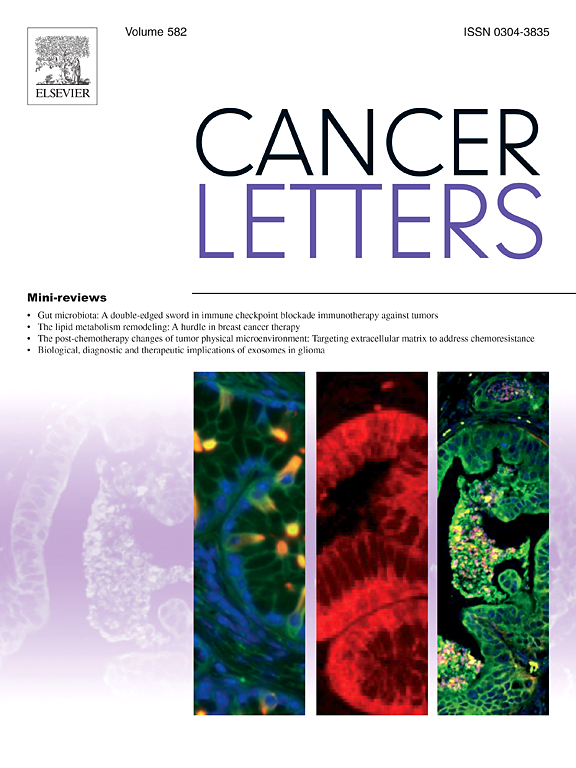吡非尼酮通过逆转胰腺癌的脱落细胞和 "冷 "微环境拮抗TGF-β1介导的加巴喷丁抗性
IF 10.1
1区 医学
Q1 ONCOLOGY
引用次数: 0
摘要
由于胰腺导管腺癌(PDAC)的基质由癌相关成纤维细胞(CAFs)构成,很少有免疫细胞浸润其中。加巴喷丁能阻碍 CAFs 产生酮酸以支持癌细胞。然而,在我们的研究中,我们发现癌细胞中的转化生长因子β1(TGF-β1)水平在加巴喷丁作用下呈剂量依赖性增加。这种 TGF-β1 的反向增加导致了 "加巴喷丁抗药性",从而导致在胰腺星状细胞存在的情况下,对 PDAC 细胞株的抗肿瘤作用会产生负作用。吡非尼酮与加巴喷丁联合使用时,能协同抑制 PDAC 的生长和凋亡抵抗。在小鼠正位 PDAC 模型中,含有加巴喷丁、吡非尼酮和天然多酚(EGCG)的 Fe3+ 介导配位纳米药物有效促进了幼稚 CD8+ T 细胞(CD44-lowCD62Lhigh)的浸润和炎性 CAFs(α-SMA-lowIL-6high)的聚集。与对照组相比,存活率提高了近两倍。此外,在使用纳米药物治疗后,我们还发现了一个新的亚群,即 Hmox1highiCAFs。Hmox1highiCAFs过度表达Cxcl10受体(Sdc4),并通过Tnfsf9-Tnfrsf9轴促进功能性CD8+T细胞浸润。总之,我们的纳米药物重塑了CAFs的表型,增强了CD8+ T细胞对肿瘤的功能性浸润,有望成为治疗PDAC的一种安全而有前景的疗法。本文章由计算机程序翻译,如有差异,请以英文原文为准。
Pirfenidone antagonizes TGF-β1-mediated gabapentin resistance via reversal of desmoplasia and the ‘cold’ microenvironment in pancreatic cancer
Owing to the desmoplastic stroma constituted by cancer-associated fibroblasts (CAFs), few immune cells infiltrate the pancreatic ductal adenocarcinoma (PDAC). Gabapentin can impede the production of ketoacids by CAFs to support cancer cells. However, in our study, we discovered a dose-dependent increase in transforming growth factor β1 (TGF-β1) levels in cancer cells in response to gabapentin. This reverse increase of TGF-β1 contributes to 'Gabapentin-resistance', leading to the antitumor effects on PDAC cell lines are negatively negotiated in the presence of pancreatic stellate cells. Pirfenidone synergistically inhibited the growth and apoptosis resistance of PDAC when combined with Gabapentin. In a mouse orthotopic PDAC model, Fe3+-mediated coordination nanodrugs, which contain gabapentin, pirfenidone and the natural polyphenol (EGCG), efficiently promoted the infiltration of naïve CD8+ T cells (CD44lowCD62Lhigh) and the accumulation of inflammatory CAFs (α-SMAlowIL-6high). This led to a nearly two-fold increase in survival compared to the control. Furthermore, we identified a new subpopulation as Hmox1highiCAFs following treatment with our nanodrugs. Hmox1highiCAFs overexpressed the Cxcl10 receptor (Sdc4) and facilitated functional CD8+ T-cell infiltration through the Tnfsf9-Tnfrsf9 axis. Overall, our nanodrugs reshape the phenotype of CAFs and enhance functional CD8+ T-cell infiltration into tumors, holding the potential to be a safe and promising therapy for PDAC.
求助全文
通过发布文献求助,成功后即可免费获取论文全文。
去求助
来源期刊

Cancer letters
医学-肿瘤学
CiteScore
17.70
自引率
2.10%
发文量
427
审稿时长
15 days
期刊介绍:
Cancer Letters is a reputable international journal that serves as a platform for significant and original contributions in cancer research. The journal welcomes both full-length articles and Mini Reviews in the wide-ranging field of basic and translational oncology. Furthermore, it frequently presents Special Issues that shed light on current and topical areas in cancer research.
Cancer Letters is highly interested in various fundamental aspects that can cater to a diverse readership. These areas include the molecular genetics and cell biology of cancer, radiation biology, molecular pathology, hormones and cancer, viral oncology, metastasis, and chemoprevention. The journal actively focuses on experimental therapeutics, particularly the advancement of targeted therapies for personalized cancer medicine, such as metronomic chemotherapy.
By publishing groundbreaking research and promoting advancements in cancer treatments, Cancer Letters aims to actively contribute to the fight against cancer and the improvement of patient outcomes.
 求助内容:
求助内容: 应助结果提醒方式:
应助结果提醒方式:


